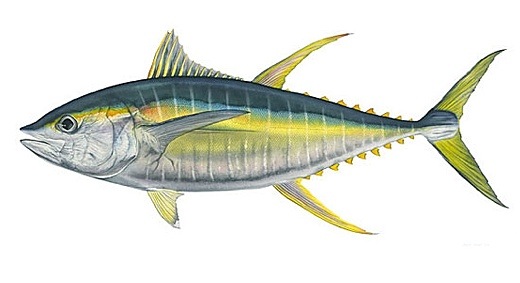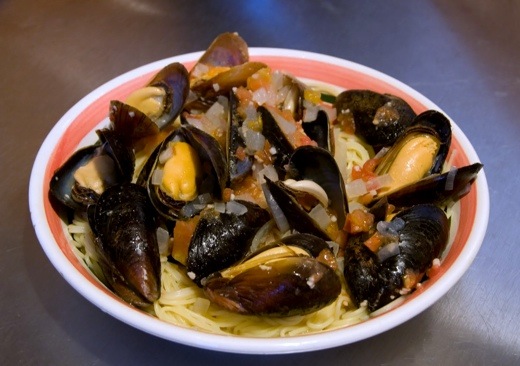SUBHEAD: Updated guide to healthy, environmentally safe seafood choices in Hawaii.
By Staff in 1 January 2017 for Monterey Bay Aquarium -
(https://www.seafoodwatch.org/-/m/sfw/pdf/guides/mba-seafoodwatch-hawaii-guide.pdf)

Image above: Illustration of Yellowfin Tuna typically caught in Pacific good to eat. From (http://tackleus.com/offshore_big_game/tuna_fishing_techniques_catching_yellow_fin_tuna).
[IB Publisher's note January 9th 2017 updated 1/13/17: Since shortly after March 11, 2011 the meltdown of three nuclear reactors at Fukushima Daiichi power plant. Radioactive material has been entering the Pacific Ocean by the outflow of hundreds of tons of contaminated cooling water (and ground water) that has been flowing through the site since the Tohuko Tsunami hit Japan. That contaminated water contains radioactive Cesium and Strontium 90 and worse. It first affected sea life native to eastern Japanese shores as well as migratory fish that near those shores.
One species in particular is Bluefin Tuna that are born in the eastern Japanese ocean waters and migrate across the Pacific. Do not eat Bluefin Tuna. Many Japanese fish products have been rejected by some private businesses and some regional governments. Yet some of those affected products make their way into the market anyway. Moreover, the radioactive material entering the ocean has spread through natural currents and has had some impact on North American western shores.
In addition, there are some reports of jetstream borne nano sized plutonium particles enclosed in carbon soot buckyballs reaching the west coast. Because of wind and ocean current patterns Hawaii seems to have dodged the worst of Fukushima radiation.
Consequently, we now are not eating any fish from the northern Pacific Ocean unless it is confirmed from local Hawaiian waters. To date we have no reports that local fish have been affected. We are also eating some locally farmed seafood including shrimp and clams. We buy only Atlantic salmon and have stopped buying tuna or fish we cannot identify.
Eventually, if Fukushima radiation is not contained, Hawaii and the southern Pacific Ocean will be contaminated and we will have to reevaluate what fish we will consider eating. This issue should be of the highest priority to the human race. The Pacific Ocean is the largest surface liquid water body in the observed universe. If the Pacific dies so do we. Water is life! See also Fukushima's Radiation Impact 1/10/17 and Fukushima radiation on West Coast 1/13/17]
World wide, the demand for seafood is increasing. Yet many populations of the large fish we enjoy eating are overfished and, in the US, we import over 80% of our seafood to meet the demand.
Destructive fishing and fish farming practices only add to the problem. By purchasing fish caught or farmed using environmentally friendly practices, you're supporting healthy, abundant oceans. Down load and print your own Seafood Watch, Hawaii Sustainable Seafood Pocket Guide, which you can carry to the grocery store, at (http://www.montereybayaquarium.org/cr/cr_seafoodwatch/download.aspx).
Other regions of the United States are available as well. These recommendations are researched by Monterey Bay Aquarium scientists. For more information about your favorite seafoods, including items not listed here, visit seafoodwatch.org.
Best Choices:

Image above: Steamed mussels with olive oil, garlic and white wine. From (http://rockdragon.blogspot.com/2010/04/cooking-steamed-mussels.html).
Good Alternatives:
By Staff in 1 January 2017 for Monterey Bay Aquarium -
(https://www.seafoodwatch.org/-/m/sfw/pdf/guides/mba-seafoodwatch-hawaii-guide.pdf)

Image above: Illustration of Yellowfin Tuna typically caught in Pacific good to eat. From (http://tackleus.com/offshore_big_game/tuna_fishing_techniques_catching_yellow_fin_tuna).
[IB Publisher's note January 9th 2017 updated 1/13/17: Since shortly after March 11, 2011 the meltdown of three nuclear reactors at Fukushima Daiichi power plant. Radioactive material has been entering the Pacific Ocean by the outflow of hundreds of tons of contaminated cooling water (and ground water) that has been flowing through the site since the Tohuko Tsunami hit Japan. That contaminated water contains radioactive Cesium and Strontium 90 and worse. It first affected sea life native to eastern Japanese shores as well as migratory fish that near those shores.
One species in particular is Bluefin Tuna that are born in the eastern Japanese ocean waters and migrate across the Pacific. Do not eat Bluefin Tuna. Many Japanese fish products have been rejected by some private businesses and some regional governments. Yet some of those affected products make their way into the market anyway. Moreover, the radioactive material entering the ocean has spread through natural currents and has had some impact on North American western shores.
In addition, there are some reports of jetstream borne nano sized plutonium particles enclosed in carbon soot buckyballs reaching the west coast. Because of wind and ocean current patterns Hawaii seems to have dodged the worst of Fukushima radiation.
Consequently, we now are not eating any fish from the northern Pacific Ocean unless it is confirmed from local Hawaiian waters. To date we have no reports that local fish have been affected. We are also eating some locally farmed seafood including shrimp and clams. We buy only Atlantic salmon and have stopped buying tuna or fish we cannot identify.
Eventually, if Fukushima radiation is not contained, Hawaii and the southern Pacific Ocean will be contaminated and we will have to reevaluate what fish we will consider eating. This issue should be of the highest priority to the human race. The Pacific Ocean is the largest surface liquid water body in the observed universe. If the Pacific dies so do we. Water is life! See also Fukushima's Radiation Impact 1/10/17 and Fukushima radiation on West Coast 1/13/17]
World wide, the demand for seafood is increasing. Yet many populations of the large fish we enjoy eating are overfished and, in the US, we import over 80% of our seafood to meet the demand.
Destructive fishing and fish farming practices only add to the problem. By purchasing fish caught or farmed using environmentally friendly practices, you're supporting healthy, abundant oceans. Down load and print your own Seafood Watch, Hawaii Sustainable Seafood Pocket Guide, which you can carry to the grocery store, at (http://www.montereybayaquarium.org/cr/cr_seafoodwatch/download.aspx).
Other regions of the United States are available as well. These recommendations are researched by Monterey Bay Aquarium scientists. For more information about your favorite seafoods, including items not listed here, visit seafoodwatch.org.
Best Choices:
- Aku/Skipjack Tuna (Pacific troll, pole and line)
- Akule/Big-eye Scad (HI net)
- Arctic Char (farmed)
- Barramundi (US & Vietnam farmed)
- Bass (US hook and line, farmed)
- Clams, Mussels & Oysters
- Kamano/Salmon (AK & New Zealand)
- Limu/Ogo/Seaweed (farmed)
- Lionfish (US)
- Lobster: Spiny (Mexico)
- Opae/Prawn: Freshwater (Canada & US)
- Opae/Shrimp (US farmed & AK)
- Opelu/Mackerel Scad (HI net)
- Papa'i/Crab: King, Snow & Tanner (AK)
- Rockfish (AK, CA, OR & WA)
- Sardines: Pacific (Canada & US)
- Scallops (farmed)
- Shutome/Swordfish (Canada & US buoy, handline, harpoon)
- Tilapia (Canada, Ecuador & US)
- Tombo/Albacore Tuna (troll, pole and line)

Image above: Steamed mussels with olive oil, garlic and white wine. From (http://rockdragon.blogspot.com/2010/04/cooking-steamed-mussels.html).
Good Alternatives:
- Ahi/Yellowfin Tuna (free school, HI longline, Pacific & Indian,Ocean troll, pole, line)
- Aku/Skipjack Tuna (free school, imported troll, pole and line, and US longline)
- Ehu/Red Snapper (HI)
- Hapu‘upu‘u/Hawaiian Grouper (HI)
- Hebi/Shortbill Spearfish (imported)
- He’e/Octopus (Portugal & Spain pot, trap and HI
- Kajiki/Blue Marlin (HI)
- Mahi Mahi (Ecuador & US longline)
- Onaga/Ruby Snapper (HI)
- Ono/Wahoo (HI)
- Opae/Shrimp (Canada & US wild,
- Ecuador & Honduras farmed)
- Opah/Moonfish (HI)
- Opakapaka/Pink Snapper (HI)
- Papa'i/Crab: Dungeness (Canada & US)
- Tilapia (China, Indonesia, Mexico & Taiwan)
- Tombo/Albacore Tuna (US longline)
- Uku/Gray Snapper (HI)
- Yellowtail (US gillnet)
- Ahi/Yellowfin Tuna (Atlantic troll, pole and line)
- Aku/Skipjack Tuna (imported purse seine)
- He’e/Octopus: Common (Portugal & Spain trawl, Mexico)
- Kajiki/Blue Marlin
- Mahi Mahi (imported)
- Mano/Sharks
- Ono/Wahoo (imported)
- ‘Opae/Shrimp (imported)
- Opah/Moonfish (imported)
- Orange Roughy
- Papa'i/Crab (Asia & Russia)
- Salmon: Atlantic (farmed)
- Sardines: Atlantic (Mediterranean)
- Shutome/Swordfish (imported longline)
- Snapper (Brazil)
- Tilapia (Colombia)
- Tombo/Albacore Tuna (except troll, pole and line, and US longline)
- Tuna: Bluefin
No comments :
Post a Comment